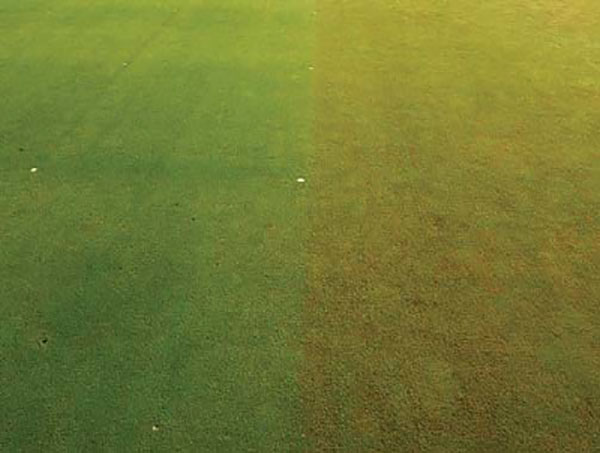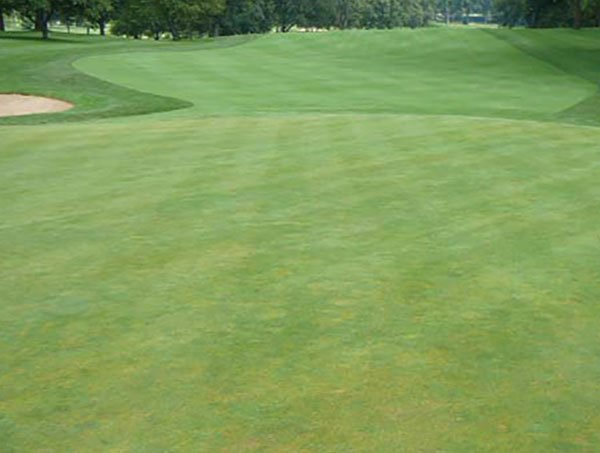Take-All Patch Overview
Take-All patch is an important root disease of all Bentgrasses. It is caused by the fungus Gaeumannomyces graminis var avenae. The disease can appear in wet, cold conditions or in warm, hot conditions when plants are experiencing stress.
.Overview
The problem
Take-All patch is an important root disease of all Bentgrasses. It is caused by the fungus Gaeumannomyces graminis var avenae. The disease can appear in wet, cold conditions or in warm, hot conditions when plants are experiencing stress. Above ground injury to Bentgrass is due to root infection below ground because the fungus disrupts vascular tissue within the root cortex. Take-All survives as Mycelium on previously infected roots and it can be a recurring problem on infected plants.
What to look for
Take-All patch symptoms usually appear in late spring to early summer during the time period coinciding with first wilt stress. Initially reddish-brown to bronze patches are small, only inches in diameter. In time individual patch size will increase, eventually reaching 0.9 m or more in diameter. A primary indication of Take-All patch in the field is that only Bentgrass is affected, whereas other turf species inside the patch remain unaffected and healthy. In severe cases, the patch interior thins significantly. Often, weeds or other grasses will colonise the thinned patches of Bentgrass.
Roots of infected creeping Bentgrass are colonised by dark brown to black ectotrophic runner hyphae. The hyphae then produce mats of Mycelium and lobed hyphopodia, which are useful for microscopic identification of Gaeumannomyces species. Infected roots change in appearance and the central root cortex loses its transparent colour and becomes darkened, with roots turning dark brown to black as the infection advances.
Creeping Bentgrass golf surfaces are vulnerable to Take-All patch and the disease is most prevalent in growing seasons that experience drought. Interestingly, Take-All symptoms lessen and often disappear during mid-summer (peak soil temperatures suppress root infection) but symptoms can return in the autumn. Over time, the disease can naturally decline, but in other situations, Take-All patch will remain a chronic disease after 10+ years.
The solution
Cultural practices that are successful in reducing Take-All patch rely on maintaining soil pH between 5.5–6.0 and use of ammonium sulfate in spring and autumn. Liming and use of nitrate forms of nitrogen should be minimised as both can enhance disease. Take-All patch severity can be reduced by applications of manganese sulfate (2 kg per ha in the spring). Fungicides are often used in conjunction with cultural strategies because soils deficient in manganese or high in pH can be difficult to correct.
Triazole (DMI) and strobilurin (QoI) fungicides are most effective against Take-All patch. Best control of Take-All patch occurs when fungicides are applied preventively in the autumn (March to May) when soil temperatures are 7–16°C at a 5 cm depth. In situations of chronic Take-All, fungicides should be reapplied preventively in the spring when soil temperatures reach >13°C for five days at a 5 cm depth with two to three applications every 21–28 days required. Curative applications in early summer can be helpful in speeding recovery. Fungicides must target infected roots, so apply at high label rates with flat fan nozzles in 800–2000 litres of water per hectare (or use 6–12 mm of irrigation immediately after application) to ensure fungicide contact with the root zone.
Dedicate® Forte Stressgard® is labelled for Take-All patch control. It also provides added control of other important turf diseases that can be active at the same time.
Signature® Stressgard® tank mixes promote plant health and reduce the effects of summer decline, as well as wilt stress associated with certain diseases such as Take-All patch.
 |
 |
Technical Information
| Solution1 | RATE (per 1000 sq ft) | Application Interval |
| Dedicate® Forte Stressgard® | 3.5 L/Ha | Preventative treatment |
To find out more information about our products and services, reach out to our team.
Always read the label before use.
Back to Other Diseases
